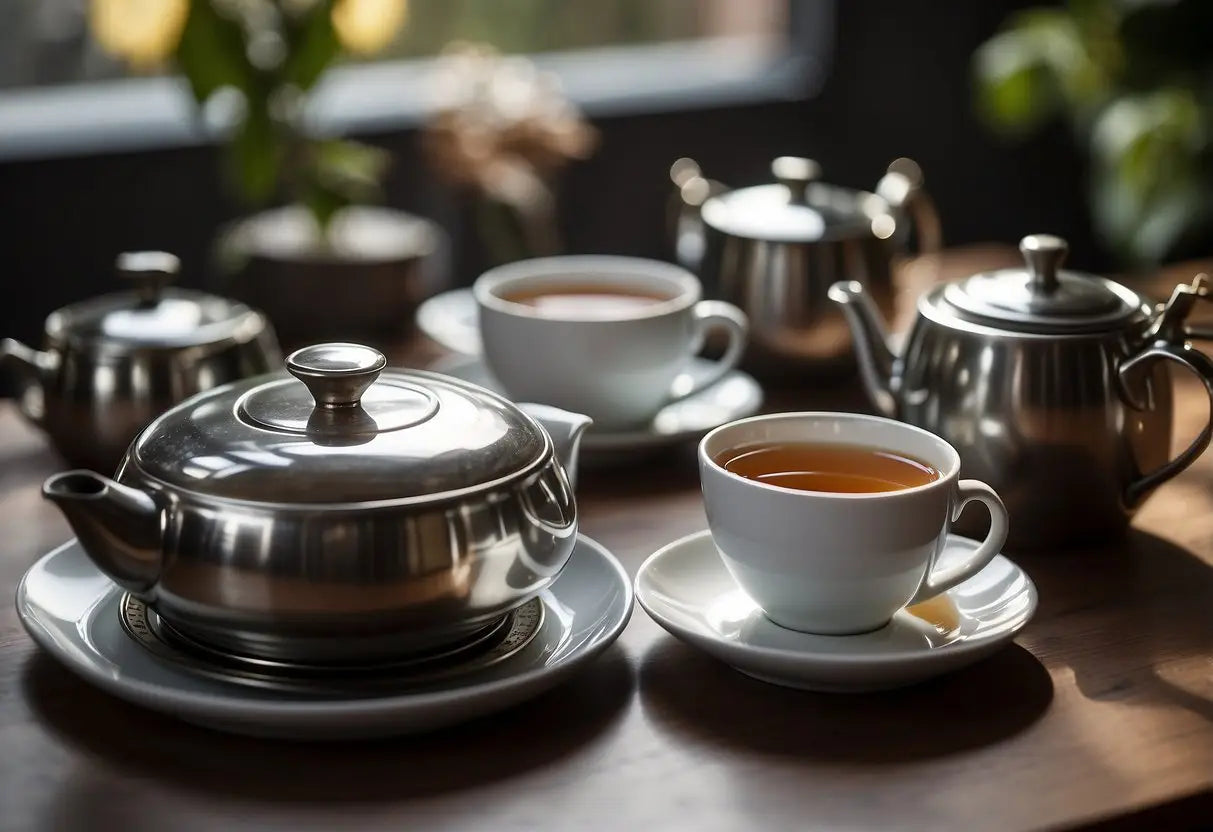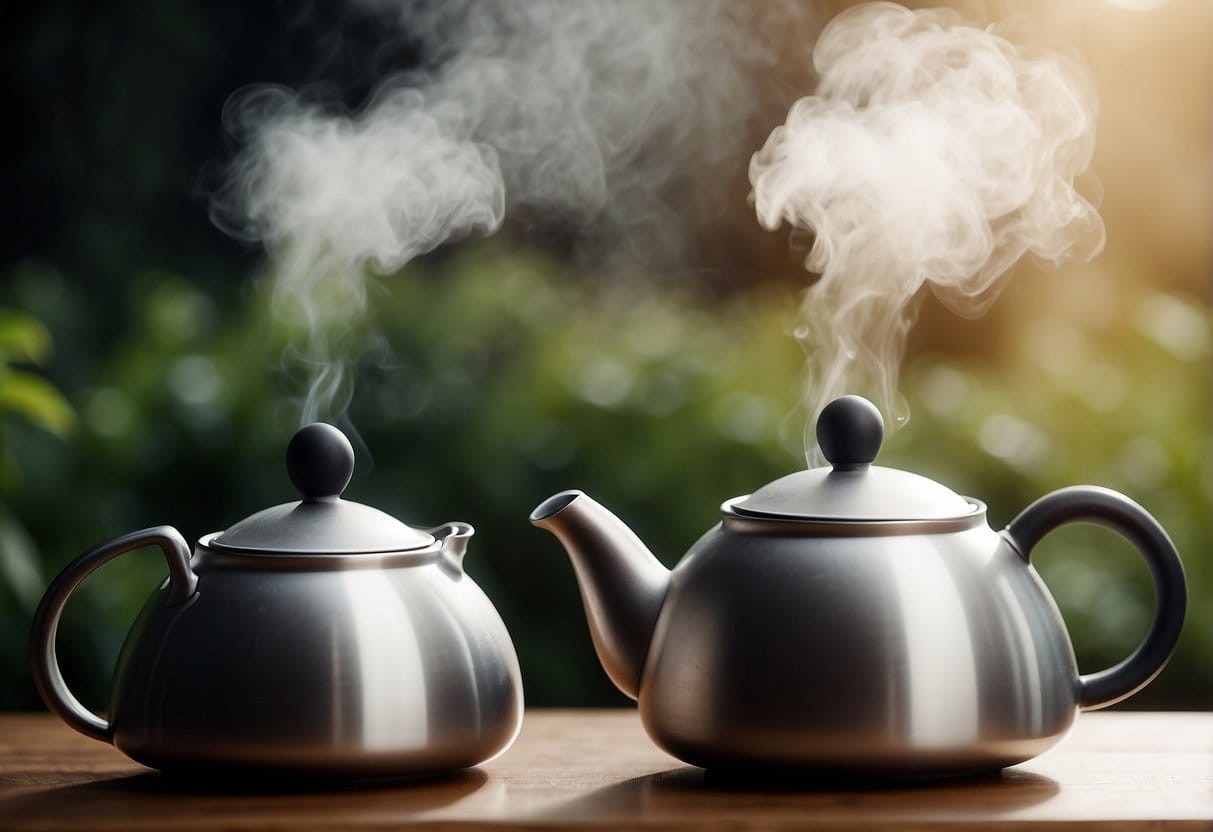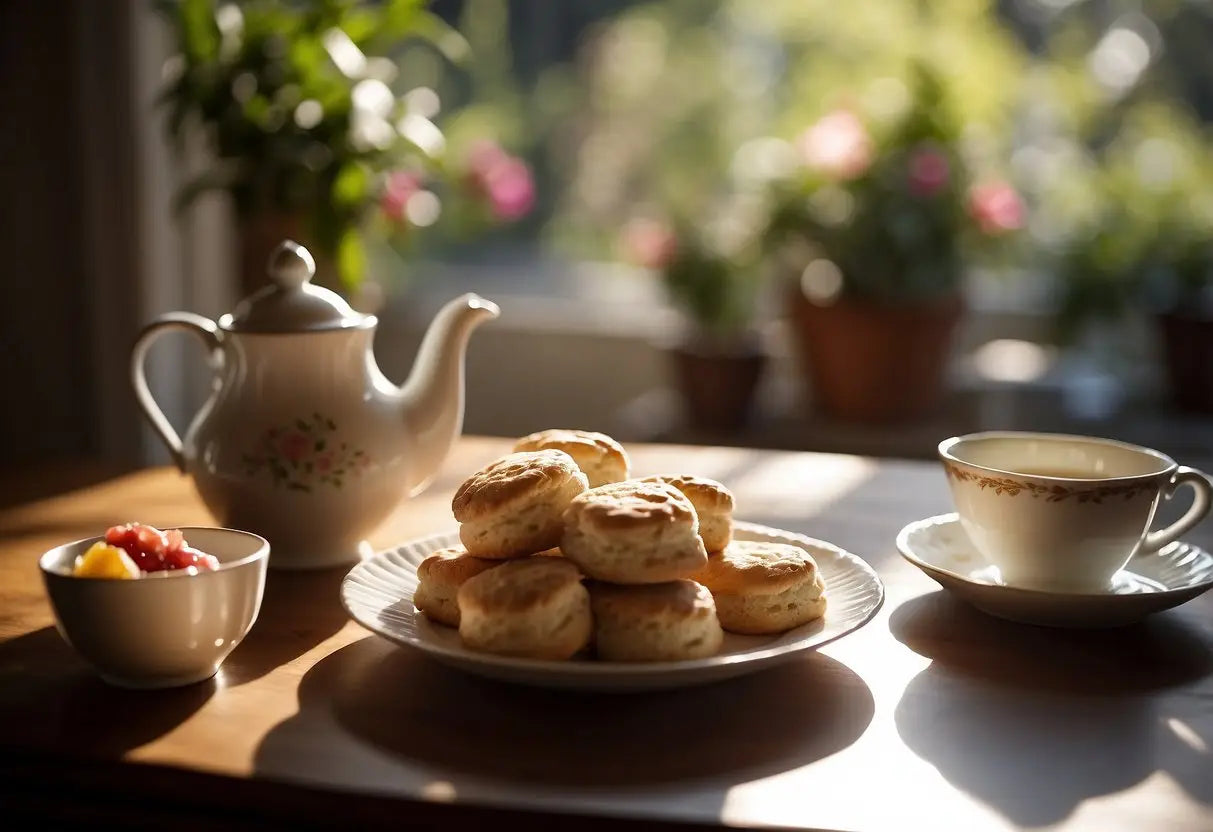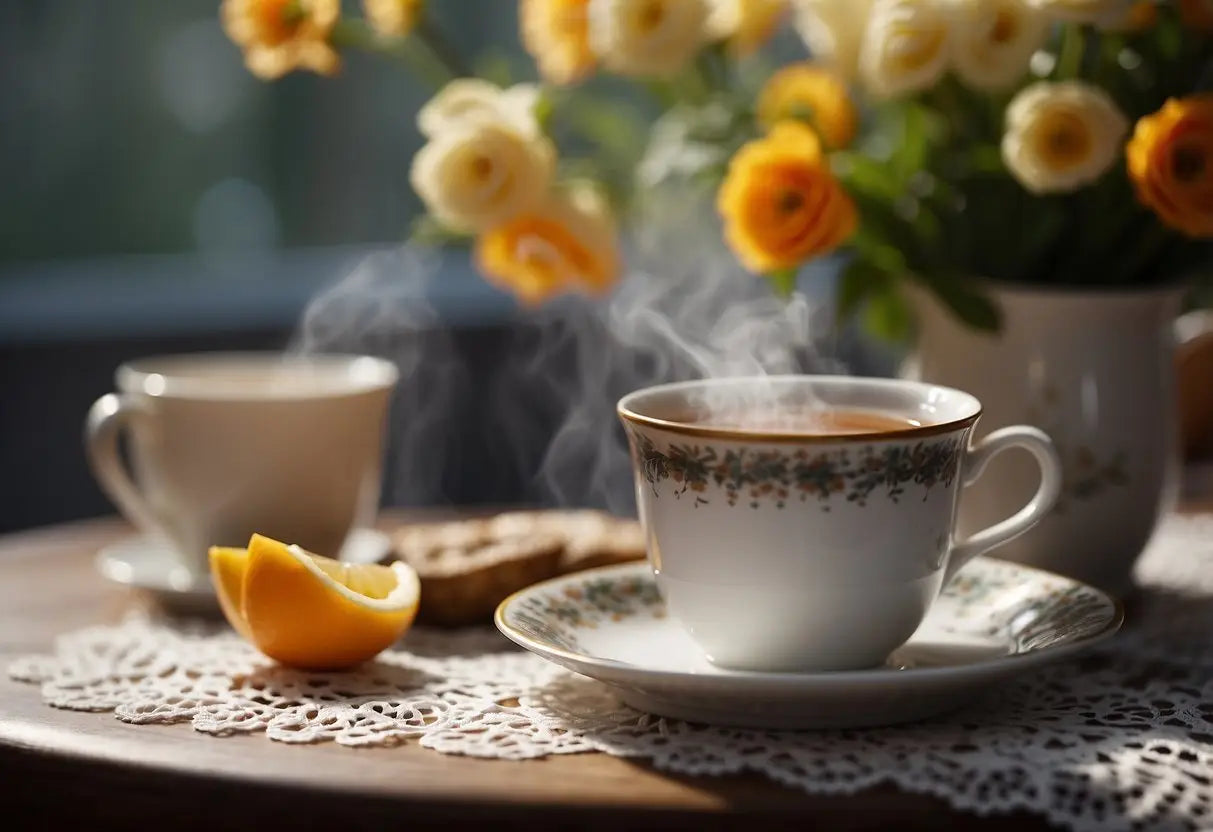Earl Grey vs English Breakfast
Earl Grey and English Breakfast are two popular types of tea.
Earl Grey is known for its distinctive bergamot flavor, a type of citrus. It usually combines black tea with bergamot oil, giving it a unique aroma and taste. Earl Grey can be enjoyed plain, with lemon, or with milk.
English Breakfast tea is a blend of several black teas, like Assam, Ceylon, and Kenyan. It has a robust, full-bodied flavor. Traditionally, it’s enjoyed with milk and sugar.
Bestsellers
Here's a quick comparison:
| Aspect | Earl Grey | English Breakfast |
|---|---|---|
| Primary Flavor | Bergamot (citrus) | Rich, malty |
| Blend Composition | Single black tea with bergamot oil | Blends of multiple black tea varieties |
| Best Enjoyed With | Lemon, milk | Milk, sugar |
| Origin | Often associated with Britain | Commonly blended in the UK |
This makes Earl Grey a fragrant option, while English Breakfast offers a heartier experience.
Historical Origin

Earl Grey and English Breakfast teas have distinct historical origins that reflect their unique flavors and cultural significance.
Earl Grey History
Earl Grey tea is named after Charles Grey, the 2nd Earl Grey, who served as British Prime Minister in the 1830s. Legend suggests the tea was gifted to him by a Chinese mandarin as a token of gratitude for saving his son. This blend combines black tea with bergamot oil, a practice inspired by Chinese tea traditions.
The tea became popular in British aristocracy and eventually made its way into middle-class homes. Today, it remains a staple in many households, often enjoyed with or without milk. The addition of bergamot differentiates it from other black teas and gives it a distinctive citrusy flavor.
English Breakfast History
English Breakfast tea originated during the 19th century in Britain. Its development is credited to tea merchants who sought a robust blend to accompany the hearty English breakfast. Typically, it includes a mix of Assam, Ceylon, and Kenyan teas, offering a strong and malty flavor.
Queen Victoria is said to have popularized the term "English Breakfast" when she brought her favorite blend back from Scotland. This tea became an integral part of British morning rituals and has maintained its reputation for being a bold and invigorating start to the day.
Initially marketed as a breakfast tea blend, it is now consumed at various times of the day, showcasing its adaptability and enduring appeal.
Tea Base and Blending

Earl Grey and English Breakfast teas are distinct in their tea bases and blending. Each has unique origins and flavor profiles, which make them beloved staples in the world of tea.
Earl Grey Tea Base
Earl Grey's base typically consists of black tea leaves. The primary varieties used are often Assam, Ceylon, or Darjeeling. What sets Earl Grey apart is the addition of bergamot oil, which gives it its signature citrusy flavor.
Lao Ban Zhang
Blenders ensure a balanced mix of leaves and bergamot. This creates a harmonious blend. While traditional recipes stick to black tea, some modern variants use green or oolong tea bases.
Quality of the bergamot oil can influence the final aroma and taste significantly. Cheaper versions might use artificial flavoring, which can affect the overall experience. Always check the ingredients for a pure blend.
English Breakfast Tea Base
English Breakfast tea is known for its robust and full-bodied flavor. It typically comprises a blend of Assam, Ceylon, and Kenyan tea leaves. This blend creates a strong, malty profile perfect for morning consumption.
The precise combination of teas can vary, but the goal remains the same: a bold, hearty brew. Unlike Earl Grey, no additional flavorings are added. The focus is purely on the strength and richness of the tea.
Some blends aim for consistency in flavor, while others celebrate slight variations in batches. This can be due to differences in growing conditions and harvest times.
Flavor Profiles

Earl Grey tea and English Breakfast tea offer distinctive flavor experiences. Earl Grey is known for its citrusy notes, while English Breakfast provides a robust and malty taste.
Earl Grey Flavor Characteristics
Earl Grey is distinguished by its iconic bergamot flavor. This oil, derived from the rind of the bergamot orange, imparts a citrus aroma and taste. It offers a refreshing and slightly floral flavor, which stands out whether the tea is served hot or iced.
The base tea used in Earl Grey is often a blend of black teas, contributing to its full-bodied character. Sometimes, green or oolong tea bases are used, resulting in lighter variations. Subtle notes of lavender or vanilla are also occasionally added to enhance the complexity.
English Breakfast Flavor Characteristics
English Breakfast tea is known for its strong and hearty flavor. It traditionally combines several black teas, including Assam, Ceylon, and Kenyan varieties. This blend creates a bold and malty taste, ideal for pairing with milk and sugar.
The tea has a rich, brisk flavor that is robust enough to complement a full English breakfast. Some may detect slight hints of honey or bread-like undertones. The consistency and boldness make it a popular choice for morning consumption, providing a bracing and satisfying experience.
Brewing Techniques

Different teas require distinct brewing techniques to bring out their best flavors. Below, you’ll find specific guidelines for brewing Earl Grey and English Breakfast teas.
Brewing Earl Grey
Tea Selection: Choose a high-quality Earl Grey with natural bergamot oil.
Water Temperature: Use water heated to 200°F (93°C).
Tea Quantity: Use 1 teaspoon (2 grams) of loose leaf tea per 8-ounce (240 ml) cup.
Steeping Time: Steep for 3-5 minutes. Oversteeping can result in bitterness.
Preparation Steps:
- Warm your teapot or mug with hot water.
- Add the Earl Grey leaves.
- Pour hot water over the leaves.
- Cover and let steep.
- Strain the leaves and enjoy.
Optional Enhancements:
- Add a slice of lemon.
- Sweeten with honey or sugar.
- A splash of milk or a dollop of cream.
Brewing English Breakfast
Tea Selection: Opt for a robust English Breakfast blend.
Water Temperature: Use boiling water at 212°F (100°C).
Tea Quantity: Use 1 teaspoon (2 grams) of loose leaf tea per 8-ounce (240 ml) cup.
Steeping Time: Steep for 4-5 minutes to extract full flavor.
Preparation Steps:
- Preheat your teapot or cup with boiling water.
- Place the tea leaves in the pot or infuser.
- Pour boiling water over the leaves.
- Cover and let steep.
- Strain or remove the leaves.
Optional Enhancements:
- Add milk or cream.
- Sweeten with sugar or honey.
- Complement with a slice of lemon.
Careful attention to these details will ensure a perfect cup every time.
Caffeine Content and Health Benefits

Both Earl Grey and English Breakfast teas contain varying amounts of caffeine.
Earl Grey:
Caffeine content typically ranges between 40-70 mg per cup. Earl Grey includes bergamot oil, which may have calming properties.
English Breakfast:
Caffeine content generally falls between 50-80 mg per cup. This makes it slightly stronger than Earl Grey.
Health Benefits
Antioxidants:
Both teas are rich in antioxidants, which help combat free radicals in your body.
Heart Health:
Earl Grey has flavonoids that may improve heart health. Black tea in English Breakfast also supports cardiovascular function.
Digestive Aid:
Earl Grey includes bergamot, which may help with digestion. English Breakfast can also aid in digestion due to its strong black tea base.
Boosts Mental Alertness
Earl Grey:
The moderate caffeine level can help improve focus without causing excessive jitteriness.
English Breakfast:
The higher caffeine content can provide a more substantial energy boost.
Each tea offers unique benefits, making them both excellent choices for different health needs. Select based on your caffeine tolerance and health goals.
Cultural Significance

Earl Grey and English Breakfast hold unique positions in the world of tea, deeply intertwined with history and cultural practices.
Earl Grey in Culture
Earl Grey tea, named after Charles Grey, the 2nd Earl Grey, carries a sense of sophistication and refinement. Traditionally associated with British aristocracy, it often graces afternoon tea tables with its distinct bergamot flavor.
Popularized in the 19th century, it remains a favorite in high-end hotels and tea rooms. Earl Grey has also permeated literature and popular culture, making appearances in works by Agatha Christie and in the Star Trek series as Captain Picard’s drink of choice.
The tea’s exotic flavor profile often inspires chefs and mixologists to incorporate it into culinary creations, from desserts to cocktails. Earl Grey chocolates, cakes, and even marinades testify to its versatile appeal.
English Breakfast in Culture
English Breakfast tea symbolizes the robust and hearty spirit of traditional British breakfast fare. Known for its strong, full-bodied flavor, it often accompanies a morning meal of eggs, bacon, and toast.
Its origins trace back to the colonial era, where the blend gained popularity among laborers needing a strong, invigorating start to their day. Over time, it became a staple in British households, embodying comfort and reliability.
In literature and history, English Breakfast tea often features in depictions of daily British life, reflecting its role in morning routines. Renowned for its comforting strength, it remains a go-to for anyone seeking a reliable cup to start their day.
Pairings and Occasions

Earl Grey is a tea that pairs wonderfully with citrus desserts like lemon cakes and scones. You may also enjoy it with light sandwiches and biscuits. The bergamot flavor complements these light, bright foods beautifully.
Occasion: Afternoon tea gatherings and light luncheons.
English Breakfast tea boasts a bold flavor that makes it a great match for hearty dishes. Consider pairing it with a traditional full English breakfast, including sausages, eggs, and toast. It also goes well with pastries and heavier desserts.
Occasion: Morning meals and casual brunches.
Pairing Recommendations:
| Tea | Food Pairing Options | Best Occasions |
|---|---|---|
| Earl Grey | Lemon cakes, scones, light sandwiches, biscuits | Afternoon tea, light luncheons |
| English Breakfast | Sausages, eggs, toast, pastries, hearty desserts | Morning meals, brunches |
When selecting a tea, consider the time of day and the type of food you're serving. Earl Grey offers a lighter touch, while English Breakfast provides a robust choice that stands up well to rich foods.
Global Popularity and Availability
Earl Grey and English Breakfast teas enjoy widespread popularity. They are commonly found in tea shops, cafés, and supermarkets around the world.
Earl Grey, known for its unique bergamot flavor, is particularly popular in Europe and North America. You will often find it in the tea selections of high-end restaurants and hotels.
English Breakfast, a robust and full-bodied blend, holds a strong presence in places like the United Kingdom and former British colonies. It is a staple in many households, often enjoyed as part of a traditional breakfast.
| Region | Earl Grey Popularity | English Breakfast Popularity |
|---|---|---|
| Europe | High | High |
| North America | High | High |
| Asia | Moderate | Moderate |
| Australia | Moderate | High |
| Africa | Low | Moderate |
Both varieties are available in loose leaf, tea bags, and many specialty blends.
In online stores, you can easily find both teas offered in various quantities and from multiple brands. This makes purchasing either type of tea convenient no matter where you are located.
Access to specialty tea shops also provides opportunities to explore unique and rare blends of Earl Grey and English Breakfast. This adds to their allure and widespread appreciation among tea enthusiasts.
← Older post Newer post →











